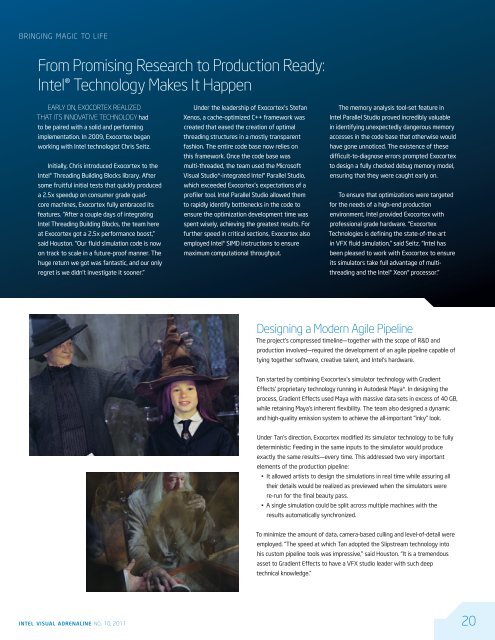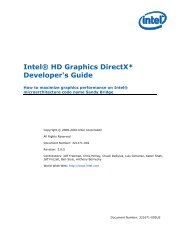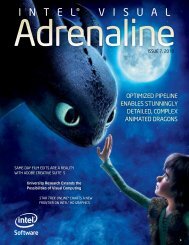Intel ® Visual
Intel ® Visual
Intel ® Visual
Create successful ePaper yourself
Turn your PDF publications into a flip-book with our unique Google optimized e-Paper software.
inging magic to life<br />
From Promising Research to Production Ready:<br />
<strong>Intel</strong><strong>®</strong> Technology Makes It Happen<br />
EARLY ON, EXOCORTEX REALIZED<br />
THAT ITS INNOVATIVE TECHNOLOGY had<br />
to be paired with a solid and performing<br />
implementation. In 2009, Exocortex began<br />
working with <strong>Intel</strong> technologist Chris Seitz.<br />
Initially, Chris introduced Exocortex to the<br />
<strong>Intel</strong><strong>®</strong> Threading Building Blocks library. After<br />
some fruitful initial tests that quickly produced<br />
a 2.5x speedup on consumer grade quad-<br />
core machines, Exocortex fully embraced its<br />
features. “After a couple days of integrating<br />
<strong>Intel</strong> Threading Building Blocks, the team here<br />
at Exocortex got a 2.5x performance boost,”<br />
said Houston. “Our fluid simulation code is now<br />
on track to scale in a future-proof manner. The<br />
huge return we got was fantastic, and our only<br />
regret is we didn’t investigate it sooner.”<br />
Under the leadership of Exocortex’s Stefan<br />
Xenos, a cache-optimized C++ framework was<br />
created that eased the creation of optimal<br />
threading structures in a mostly transparent<br />
fashion. The entire code base now relies on<br />
this framework. Once the code base was<br />
multi-threaded, the team used the Microsoft<br />
<strong>Visual</strong> Studio*-integrated <strong>Intel</strong><strong>®</strong> Parallel Studio,<br />
which exceeded Exocortex’s expectations of a<br />
profiler tool. <strong>Intel</strong> Parallel Studio allowed them<br />
to rapidly identify bottlenecks in the code to<br />
ensure the optimization development time was<br />
spent wisely, achieving the greatest results. For<br />
further speed in critical sections, Exocortex also<br />
employed <strong>Intel</strong><strong>®</strong> SIMD instructions to ensure<br />
maximum computational throughput.<br />
The memory analysis tool-set feature in<br />
<strong>Intel</strong> Parallel Studio proved incredibly valuable<br />
in identifying unexpectedly dangerous memory<br />
accesses in the code base that otherwise would<br />
have gone unnoticed. The existence of these<br />
difficult-to-diagnose errors prompted Exocortex<br />
to design a fully checked debug memory model,<br />
ensuring that they were caught early on.<br />
To ensure that optimizations were targeted<br />
for the needs of a high-end production<br />
environment, <strong>Intel</strong> provided Exocortex with<br />
professional grade hardware. “Exocortex<br />
Technologies is defining the state-of-the-art<br />
in VFX fluid simulation,” said Seitz. “<strong>Intel</strong> has<br />
been pleased to work with Exocortex to ensure<br />
its simulators take full advantage of multithreading<br />
and the <strong>Intel</strong><strong>®</strong> Xeon<strong>®</strong> processor.”<br />
Designing a Modern Agile Pipeline<br />
The project’s compressed timeline—together with the scope of R&D and<br />
production involved—required the development of an agile pipeline capable of<br />
tying together software, creative talent, and <strong>Intel</strong>’s hardware.<br />
Tan started by combining Exocortex’s simulator technology with Gradient<br />
Effects’ proprietary technology running in Autodesk Maya*. In designing the<br />
process, Gradient Effects used Maya with massive data sets in excess of 40 GB,<br />
while retaining Maya’s inherent flexibility. The team also designed a dynamic<br />
and high-quality emission system to achieve the all-important “inky” look.<br />
Under Tan’s direction, Exocortex modified its simulator technology to be fully<br />
deterministic: Feeding in the same inputs to the simulator would produce<br />
exactly the same results—every time. This addressed two very important<br />
elements of the production pipeline:<br />
• It allowed artists to design the simulations in real time while assuring all<br />
their details would be realized as previewed when the simulators were<br />
re-run for the final beauty pass.<br />
• A single simulation could be split across multiple machines with the<br />
results automatically synchronized.<br />
To minimize the amount of data, camera-based culling and level-of-detail were<br />
employed. “The speed at which Tan adopted the Slipstream technology into<br />
his custom pipeline tools was impressive,” said Houston. “It is a tremendous<br />
asset to Gradient Effects to have a VFX studio leader with such deep<br />
technical knowledge.”<br />
intel visual adrenaline no. 10, 2011 20













